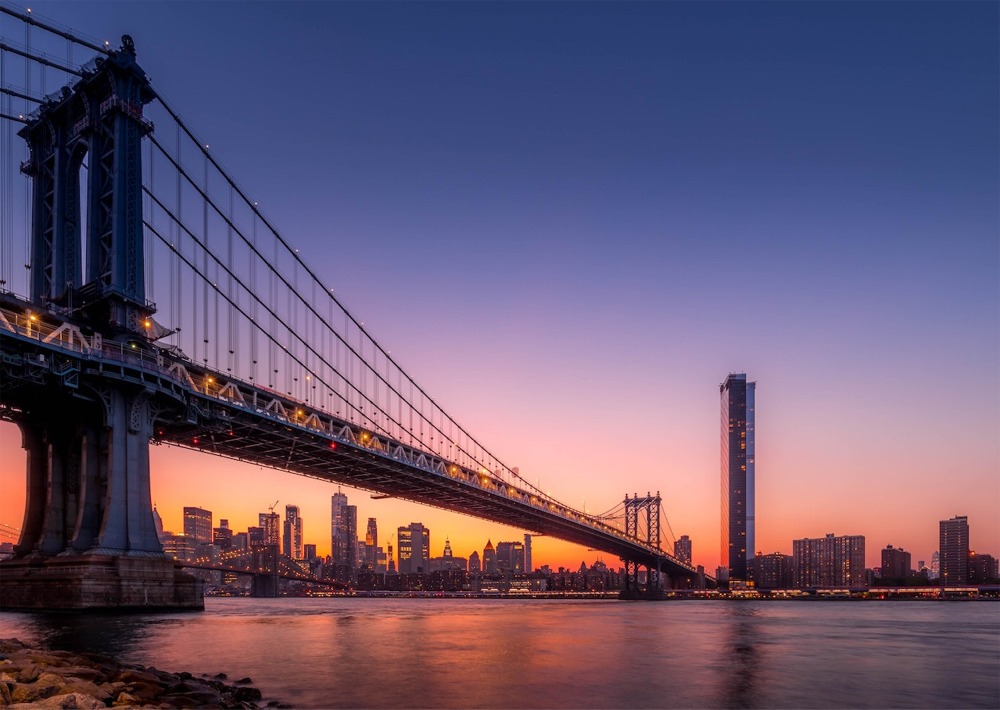Manhattan Bridge Sunset
Home > New York State Photographs > New York > Manhattan Bridge Sunset

The sun had just set, painting the sky in a thousand shades of pink and orange with the Manhattan skyline strikingly silhouetted in the background. The blue hour was upon the city, a transition period from day to night that gave it a mysterious otherworldly feel. The foreboding darkening sky led the way for the twinkling city lights to appear one by one.
The mighty Manhattan Bridge, extending from its eastern pier to the western one, loomed in the foreground as if to guard the breathtakingly beautiful sunset. The East River, which had seen so many ships and ferries pass through, rippled with a million eddies and currents and reflected the vivid display on the horizon. The lights from the bridge illuminated the gentle waves in the water and cast a surreal glow on the whole scene.
It was nothing short of magical. The dying light of the day in conjunction with the nascent lights of the night served as a reminder of the ever-changing nature of life, of how the day gives way to the night and how the night is eventually replaced by a new day.
The serene beauty and strange stillness of the city at twilight, suspended between two worlds, captivatingly combined to create a moment of perfect serenity and peacefulness, a moment that would forever be etched in my memory.
Manhattan Bridge
The Manhattan Bridge is a historic and iconic suspension bridge that spans the Lower East River, connecting the boroughs of Manhattan and Brooklyn in New York City. It is one of the city's major river crossings and an important transportation artery. Here's an overview of the Manhattan Bridge:
History and Construction
- The Manhattan Bridge was designed by the suspension bridge engineer Leon Moisseiff and opened to traffic on December 31, 1909.
- It was the third bridge to be constructed across the Lower East River, following the Brooklyn Bridge and the Williamsburg Bridge.
- The bridge's design features a main suspension span and two side spans, flanked by viaducts on either end. The central spans are supported by large towers made of steel.
Architecture and Features
- The bridge's distinctive appearance includes a "web" of vertical cables descending from the main suspension cables, giving it a classical and recognizable look.
- The Manhattan Bridge has a higher profile compared to the nearby Brooklyn Bridge, and its tracks are positioned on the outside of the bridge structure, making it a key element in the city's transit network.
Transportation Significance
- The Manhattan Bridge is a vital link for both vehicular and pedestrian traffic between Manhattan and Brooklyn.
- It carries 7 vehicle lanes for cars and trucks, as well as four tracks for subway trains. The New York City Subway's B, D N and Q lines use the bridge to cross the East River.
- The bridge has also accommodated streetcars in the past and currently has a pedestrian walkway and a bike path, making it accessible to pedestrians and cyclists.
Cultural and Iconic Importance
- The Manhattan Bridge's unique design and its prominent position in the city's skyline have made it a symbol of New York City.
- It has been featured in numerous films, television shows, photographs, and artistic works, contributing to its cultural significance.
- The bridge offers impressive views of the Manhattan skyline and the East River, making it a popular spot for tourists and photographers.
Renovations and Upgrades
- Over the years, the Manhattan Bridge has undergone various renovation and restoration projects to ensure its safety and maintain its historical integrity.
- Upgrades have included replacing sections of the bridge deck, repairing cables, and improving subway tracks and infrastructure.
Challenges and Resilience
- Like many older infrastructure elements in New York City, the Manhattan Bridge has faced challenges related to wear and tear, increasing traffic demands, and the need for modernization.
- It has endured the effects of weather, aging, and even a fire that damaged a portion of the bridge's upper structure in the early 20th century.
In summary, the Manhattan Bridge is a significant and iconic part of New York City's transportation network and cultural landscape. Its unique design, historical importance, and role in connecting Manhattan and Brooklyn make it a cherished landmark in the city.


